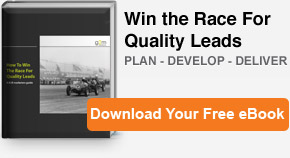Is email a marketing tool that has had its day? We hear so much about the effectiveness of new social media communication methods, perhaps it's time for email to hang up its boots, sit back and enjoy a well-earned retirement.
The answer, we argue, is a resounding "No!", or perhaps more accurately, "Errr, no but...", for whilst email remains a critical communication tool in the B2B Marketer's kitbag, its role is changing.
Email as a "top of funnel" communication tool, barging its way uninvited into a prospects inbox, is expensive and ineffective. Increasingly strict SPAM regulations, ever improving SPAM filtering systems and an increasing intolerance for such methods means you should consign this communication technique to the scrapheap. Instead focus on inbound marketing techniques to get yourself found by your target prospects.
However, as a way of communicating with people who know you and what your organisation does, email remains an exceptionally effective way of communication. This is especially true in the middle of the funnel, when a buyer has acknowedged they have a problem that needs fixing, established what they need and started the process of investigation. Email is a perfect lead nurturing tactic, drawing your prospect down the funnel towards the point of engagement with sales.
That said, email is just the vehicle - the method of transportation for your marketing message. The message itself is bought to life by your powerful, remarkable content.
So here are some top tips for using email in your marketing campaigns.
#1 Beauty Is Only Skin-Deep
Too many times the look and feel of emails is given priority over the message. Utlimately, we want results (ie. the recipient to take action) and this will happen because of what you say and offer - not how pretty the email looks.
Set your goal for the email. What do you want to achieve? In the majority of cases an email's aim is to get the reader to click. That's it. The website landing page does the harder job of conversion into a lead. The email's role is to get them there.
#2 Deliver A Single Message
In the majority of cases your email should have a single clear message. It's sometimes tempting to add, "Oh whilst I've got your attention perhaps I could interest you in..." and then insert an invitation to your next breakfast briefing, a special offer, and so on.
The exception to this general rule is when the email is being used in a customer newsletter style communication - perhaps quarterly, where the aim is, in fact, to provide a smorgasbord of clickable content for the reader to engage with your organisation in a broader way. Here the aim is to expand the reader's knowledge of what you do.
#3 Focus On First Impressions
Professional journalists are taught from the very start of their careers to focus more effort on their headline and opening sentence than on the rest of the article put together. They know a thing or two about communications and marketers should employ the same rule. With many email engines utilising a preview pane, many readers will see your email title and the first sentence. This is your best chance of getting your reader to open the email and read on. Make the most of this prime screen "real estate".
#4 Test, Test, & Test Again
Marketing Sherpa's 2012 Email Marketing Benchmark Report, found that only 42% of marketers test their emails. One of the primary benefits of digital marketing is the ability to measure and improve your activity. What a crime that almost 60% of marketers fail to do so!
But testing has its pitfalls too. Make sure you isolate what you test. Test one variable at a time, change the time of day you send your emails OR the email title. Don't change both simultaneously or you won't be able to isolate what caused any change in click through rate.
#5 Using Images
The use of images is an emotive topic that triggers much debate. The answer depends much on the industry sector you're in and whether using visual imagery is required (to show a product's features for example).
In general, images can be powerful in helping tell a story or emphasize a concept but shouldn't get in the way of the message, both literally and figuratively. Consider right-justifying the image so it doesn't interrupt the flow of the text. Remember that a decent proportion of your recipients will have images turned off in their email settings, so make sure your email works without images just as well as it does with images enabled.
Don't forget that your call to action can be an image as well. Testing has shown that orange and green "Click Here" style buttons are more likely to encourage a reader to click than other colours and certainly more than simple hyperlinked text.
#6 Use Your Logo & Branding
With most professionals facing a tsunami of daily emails, careful, consistent use of your logo, brand and colours, across emails, landing pages and your main website is a handy reminder that they know you and will decrease the chances of your email getting instantly deleted.
Email is one vital element of your lead generation engine. To read more about building an effective marketing engine for your business, please download our complementary eBook, The Race For Leads.
How do you use emai in your business? Do you agree its role is changing from a top of funnel to a mid funnel tactic? Please feel free to comment below.


